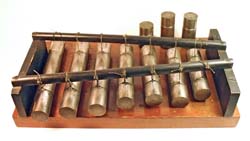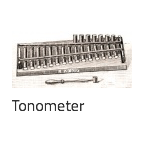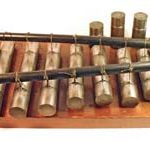Artefacts
Tonometer
Tonometer
A tonometer consists of a series of steel cylinders that resonate at specific frequencies upon being struck with a metal hammer. They are used as standards for high frequencies, in the same manner as tuning forks. The transverse vibrational frequencies (i.e. fundamental and harmonics) of a given cylinder depend on the length, elastic modulus, and linear density of the metal.
Each cylinder hangs by two strings located 22.4% of the total length from each end–at the cylinder’s nodal points (see tone bar for more information). This minimizes damping.
The tonometer pictured above was created by Rudolph Koenig. It spans three full octaves; the bars are labeled: Ut-7 (i.e. Do-7), Mi-7, Sol-7, Ut-8, Mi-8, Sol-8, Ut-9, Mi-9, Sol-9 and Ut-10. They are also labeled with units of vibrations per second, i.e. twice the frequency (8192, 10240, 12288, 16384, 20480, 24576, 32768, 40960, 49152, and 65536 vibrations per second). The three highest frequency bars are beyond the human audible range (over 20 KHz). Even though these cannot be heard directly, they can be detected by beating them against bars an octave lower.
Text & figures by Brian Tinker, republished with the kind permission of Case Western Reserve University and William Fickinger, Prof Emeritus of Physics.
https://physics.case.edu/about/history/antique-physics-instruments/tonometer-2/
© 2015 – 2025 Humboldt-Universität zu Berlin









